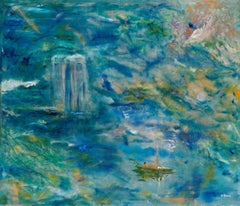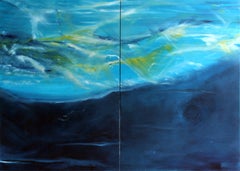Peter Busa Art
Peter Busa was a central figure in the New York School, a truly original thinker and a pioneer of modern art. Though difficult to categorize, his work was influenced by his close associations with Matta, Pollock, Motherwell, Baziotes, Kamrowski and Hofmann. His early work is of two types. The first was based on the automatic technique of the Surrealists. The paintings of this type relied heavily on poured or dripped paint and dated from the mid-40s typically. The second type of painting was more geometric, often angular, and these paintings were heavily influenced by Native American design motifs. These are commonly referred to as "Indian Space paintings." Busa's Indian Space paintings date from the late thirties to the late fifties. After abandoning Indian Space for styles more closely akin to straightforward abstract expressionism and geometric abstraction during the sixties and seventies, Busa returned to an evolved form of Indian Space painting in the eighties. In his introduction to the catalog for Peter Busa's 50-year retrospective exhibition, Life Colors Art, Robert Metzger summarized Busa's career by saying, "Busa has presented problems for…art historians since his highly original and diverse body of work and his mastery of styles…have made him difficult to pigeonhole. His expansive repertory of forms defies translation into verbal language for they reveal truths that cannot be expressed in words. …despite his successful exhibitions with such leading galleries as Peggy Guggenheim, Carlebach, and Bertha Schaefer he [has not yet] made it into the celebrity bandwagon of dealers,…collectors, and the art press. The personal poetry and awesome range and depth of his body of work remain one of the great undiscovered treasures of 20th-century American art…."
1950s Abstract Expressionist Peter Busa Art
Oil
2010s Abstract Expressionist Peter Busa Art
Oil
2010s Abstract Expressionist Peter Busa Art
Oil
1960s Abstract Expressionist Peter Busa Art
Oil
2010s Abstract Expressionist Peter Busa Art
Oil
Mid-20th Century Abstract Expressionist Peter Busa Art
Canvas, Oil
2010s Abstract Expressionist Peter Busa Art
Oil
1950s Abstract Expressionist Peter Busa Art
Canvas, Oil
1950s Abstract Expressionist Peter Busa Art
Canvas, Oil
1930s Abstract Expressionist Peter Busa Art
Canvas, Oil
1950s Abstract Expressionist Peter Busa Art
Canvas, Oil
Late 20th Century Abstract Expressionist Peter Busa Art
Canvas, Oil
1950s Abstract Expressionist Peter Busa Art
Canvas, Oil


